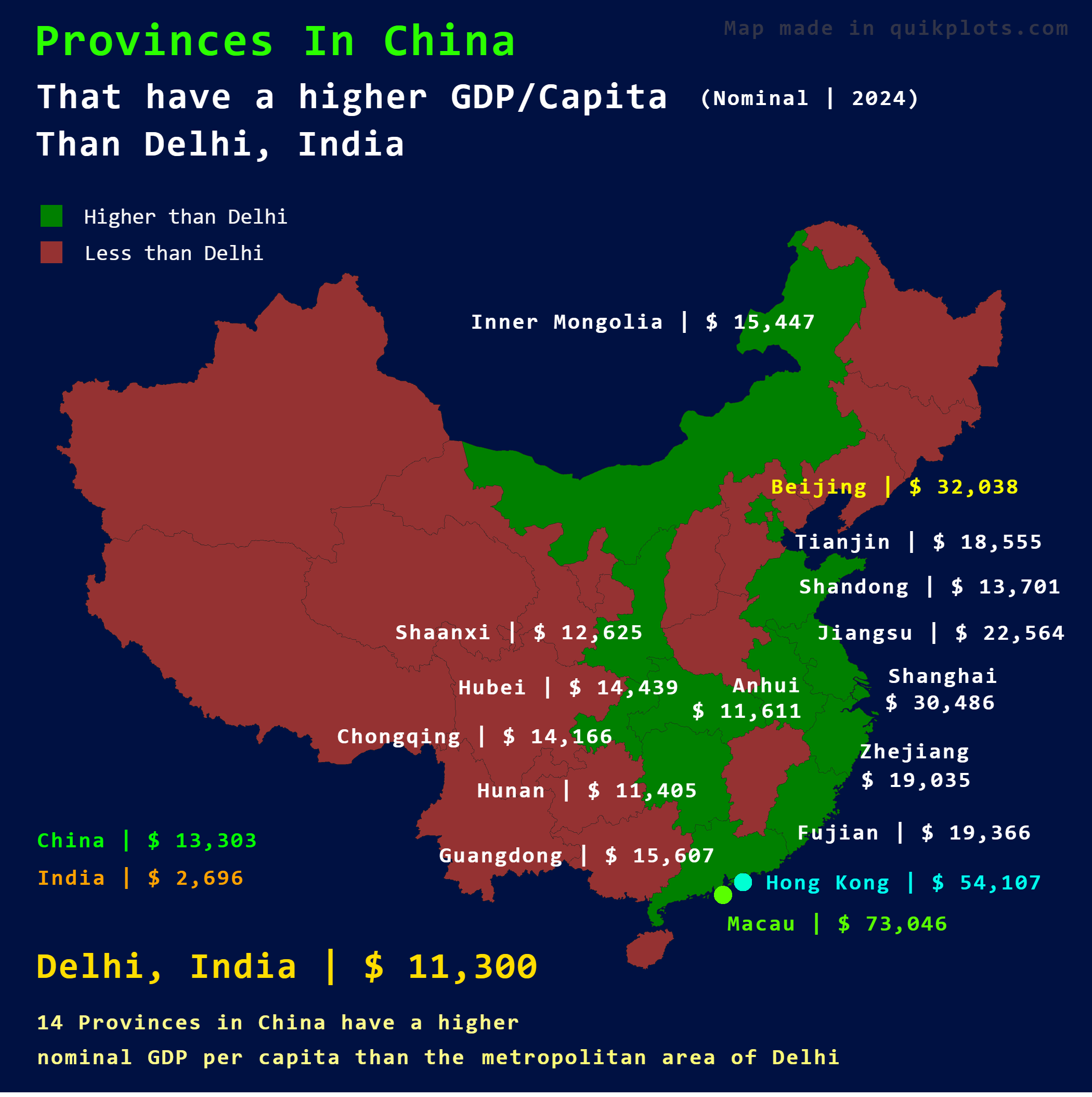Map of Chinese Provinces with Higher GDP Per Capita than Delhi


David Chen
Data Visualization Specialist
David Chen is an expert in transforming complex geographic datasets into compelling visual narratives. He combines his background in computer science ...
Geographic Analysis
What This Map Shows
This map illustrates which provinces in China have a higher nominal GDP per capita compared to Delhi, India. By placing the economic performance of various Chinese provinces alongside that of one of India's most significant urban centers, we can gain insights into the economic disparities between these two populous nations. With China's economy projected to reach approximately $18.3 trillion in 2024, while India's economy is expected to be around $3.9 trillion, this comparison sheds light on the economic landscape and the wealth distribution within these regions.
Deep Dive into GDP Per Capita
GDP per capita is a critical measure of economic health and individual prosperity. It provides an average economic output per person, highlighting not just the size of an economy, but how wealth is distributed among its citizens. In this case, we are comparing the economic performance of provinces in China against Delhi, which is not only a bustling metropolis but also one of India's major economic hubs.
Interestingly, the nominal GDP per capita varies significantly across China’s provinces, with some regions showcasing impressive economic growth. For instance, as of 2024, Shanghai leads with a staggering GDP per capita, reflecting its status as a global financial center. Similarly, provinces like Beijing, Guangdong, and Jiangsu also report high GDP per capita figures, demonstrating their economic prowess and development.
What’s fascinating is that these figures highlight the disparities within India as well. Delhi, with its GDP per capita being considerably lower than these leading Chinese provinces, faces challenges in terms of economic inequality and resource distribution. While Delhi is one of the wealthiest regions in India, it still falls short when compared to several Chinese provinces, indicating a more uneven economic landscape in India.
The reasons behind the higher GDP per capita in certain Chinese provinces can be attributed to various factors, including industrialization, foreign investment, infrastructure development, and government policies that have been favorable towards economic growth. For example, regions like Guangdong have benefitted from being at the forefront of manufacturing and export, while Shanghai has developed into a hub for finance and technology.
Regional Analysis
When we analyze the map, we see distinct regional characteristics that contribute to the economic figures. For example, the eastern coastal provinces of China, such as Zhejiang and Fujian, showcase higher GDP per capita due to their vibrant trade and manufacturing sectors. In contrast, western provinces like Tibet and Qinghai lag behind, primarily due to geographical challenges and less economic development.
In comparison, Delhi's economy is heavily service-oriented, with a significant contribution from IT, telecommunications, and financial services. However, the growth rate in these sectors has not kept pace with that of major Chinese cities, which have diversified and expanded their economic bases.
Interestingly, the economic strategies employed by China, including state-led capitalism and massive infrastructure investments, have enabled faster growth in their GDP per capita. Conversely, India’s economic policies have often been critiqued for being more conservative and slower to adapt to global market changes.
Significance and Impact
Understanding the economic landscapes of China and India, particularly through the lens of GDP per capita, is crucial for multiple reasons. Firstly, it provides insights into the living standards of the populations in these regions. A higher GDP per capita generally corresponds to better access to services such as healthcare, education, and infrastructure.
Moreover, as these two countries continue to grow and evolve, the economic competition between them intensifies. The disparities highlighted by this map can influence foreign investment decisions, trade relations, and even geopolitical strategies. For instance, as China continues to expand its economic might, India’s policymakers may need to take a closer look at how they can enhance their economic output and improve their GDP per capita.
In conclusion, this comparative analysis not only sheds light on the current economic situation but also raises important questions about future growth trajectories. Will India manage to catch up with its neighbor, or will China maintain its edge in economic prosperity? The answers to these questions will shape the future of both nations and their global standing in the years to come.
Visualization Details
- Published
- September 28, 2025
- Views
- 56
Comments
Loading comments...